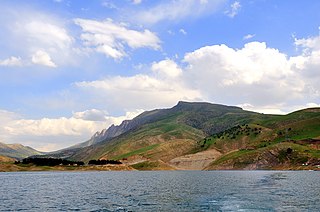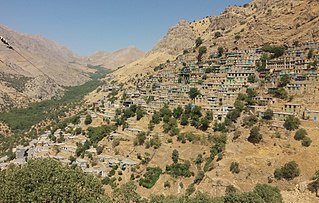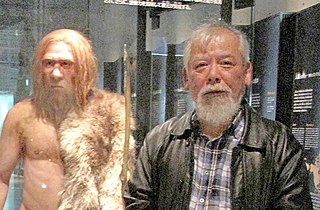Lower Paleolithic Period
- c. 800,000-200,000 BCE: Prehistoric hominins lived in the Iranian plateau specifically in Baqbaqu near Kashafrud, Kanisib near Piranshahr, Ganj Par and Darband Caves in Gilan, and Shiwatoo near Mahabad. [2]

The Palaeolithic Era in Iran is the prehistory of Iran in the period from c. 800,000 BCE to c. 11,000 BCE and can be divided into the Lower Paleolithic, Middle Paleolithic and Upper Paleolithic periods. [1]


The Epipalaeolithic Near East designates the Epipalaeolithic in the prehistory of the Near East. It is the period after the Upper Palaeolithic and before the Neolithic, between approximately 20,000 and 10,000 years Before Present (BP). The people of the Epipalaeolithic were nomadic hunter-gatherers who generally lived in small, seasonal camps rather than permanent villages. They made sophisticated stone tools using microliths—small, finely-produced blades that were hafted in wooden implements. These are the primary artifacts by which archaeologists recognise and classify Epipalaeolithic sites.

Kermanshah province is one of the 31 provinces of Iran, bordering Iraq. Its capital is the city of Kermanshah.

The Zagros Mountains are a mountain range in Iran, northern Iraq, and southeastern Turkey. The mountain range has a total length of 1,600 km. The Zagros range begins in northwestern Iran and roughly follows Iran's western border while covering much of southeastern Turkey and northeastern Iraq. From this border region, the range continues southeast to the waters of the Persian Gulf. It spans the southern parts of the Armenian highlands, and the whole length of the western and southwestern Iranian plateau, ending at the Strait of Hormuz. The highest point is Mount Dena, at 4,409 metres (14,465 ft).
The Middle Paleolithic is the second subdivision of the Paleolithic or Old Stone Age as it is understood in Europe, Africa and Asia. The term Middle Stone Age is used as an equivalent or a synonym for the Middle Paleolithic in African archeology. The Middle Paleolithic broadly spanned from 300,000 to 50,000 years ago. There are considerable dating differences between regions. The Middle Paleolithic was succeeded by the Upper Paleolithic subdivision which first began between 50,000 and 40,000 years ago. Pettit and White date the Early Middle Paleolithic in Great Britain to about 325,000 to 180,000 years ago, and the Late Middle Paleolithic as about 60,000 to 35,000 years ago. The Middle Paleolithic was in the geological Chibanian and Late Pleistocene ages.

The Levallois technique is a name given by archaeologists to a distinctive type of stone knapping developed around 250,000 to 400,000 years ago during the Middle Palaeolithic period. It is part of the Mousterian stone tool industry, and was used by the Neanderthals in Europe and by modern humans in other regions such as the Levant.

The Little Zab or Lower Zab is a river that originates in Iran and joins the Tigris just south of Al Zab in the Kurdistan region of Iraq. The Little Zab is approximately 400 kilometres (250 mi) long and drains an area of about 22,000 square kilometres (8,500 sq mi). The river is fed by rainfall and snowmelt, resulting in a peak discharge in the spring and low water in the summer and early fall. Two dams built on the Little Zab regulate the river flow, providing water for irrigation and generating hydroelectricity. The Zagros Mountains have been populated since at least the Lower Palaeolithic, but the earliest archaeological site in the Little Zab basin, Barda Balka, dates to the Middle Palaeolithic. Human occupation of the Little Zab basin has been attested for every period since then.
The Baradostian culture was an Upper Paleolithic flint industry culture found in the Zagros region in the border-country between Iraq and Iran. It was preceded by the Middle Paleolithic Mousterian culture, directly overlying it without an intervening bladelet industry. This culture is known for the high percentage of burins and some of these were similar to the distinctive nosed profile of the Aurignacian burins.
Zarzian culture is an archaeological culture of late Paleolithic and Mesolithic in Southwest Asia.

Ganj Dareh is a Neolithic settlement in western Iran. It is located in the Harsin County in east of Kermanshah Province, in the central Zagros Mountains.
The prehistory of the Levant includes the various cultural changes that occurred, as revealed by archaeological evidence, prior to recorded traditions in the area of the Levant. Archaeological evidence suggests that Homo sapiens and other hominid species originated in Africa and that one of the routes taken to colonize Eurasia was through the Sinai Peninsula desert and the Levant, which means that this is one of the most occupied locations in the history of the Earth. Not only have many cultures lived here, but also many species of the genus Homo. In addition, this region is one of the centers for the development of agriculture.
Warwasi is a Paleolithic rockshelter site located at north of Kermanshah in western Iran. It was excavated by Bruce Howe under direction of late Robert Braidwood in the 1960s. This site contains a rich archaeological sequence from Middle Paleolithic to late Epipaleolithic.

Yafteh is an Upper Paleolithic cave located at the foot of Yafteh Mountain in the Zagros Mountains range, located northwest of Khoramabad in western Zagros, Lorestan Province of western Iran.

Fereidoun Biglari is an Iranian archaeologist and a museum curator.

Cultural Landscape of Hawraman or Cultural Landscape of Uramanat is the 26th tangible cultural heritage of Iran. This remote and mountainous landscape bears testimony to the traditional culture of the Hawrami people, an agropastoral Gorani tribe that has inhabited the region since about 3000 BCE. The property, at the heart of the Zagros Mountains in the provinces of Kurdistan and Kermanshah along the western border of Iran.

Bisitun Cave is an archaeological site of prehistoric human habitation in the Zagros Mountains in the Kermanshah province, north-west Iran. Bisitun Cave is one of five caves situated at the base of The Rock of Bisitun, a 1,300 m (4,300 ft) high cliff within the Chamchamal Plain. It was first excavated in 1949 by Carlton Coon, and is notable for the discovery of Mousterian stone tools of the Middle Paleolithic, as well as the remains of 109 identifiable species of Pleistocene mammals, and hominid remains. Harold Dibble described the stone tools as having strong Levallois components. All artefacts are apparently from the same period.

Jacques Jaubert is a French prehistorian and professor of Paleolithic archaeology at the University of Bordeaux.

The prehistory of the Iranian plateau, and the wider region now known as Greater Iran, as part of the prehistory of the Near East is conventionally divided into the Paleolithic, Epipaleolithic, Neolithic, Chalcolithic, Bronze Age and Iron Age periods, spanning the time from the first settlement by archaic humans about a million years ago until the beginning of the historical record during the Neo-Assyrian Empire, in the 8th century BC.

Theopetra Cave is a limestone cave located in Theopetra village of Meteora municipality, Thessaly, Greece. It is situated on the northeast side of a limestone rock formation that is 3 km (2 mi) south of Kalambaka. The site has become increasingly important as human presence is attributed to all periods of the Middle and Upper Paleolithic, the Mesolithic, Neolithic and beyond, bridging the Pleistocene with the Holocene.
Trialetian is the name for an Upper Paleolithic-Epipaleolithic stone tool industry from the South Caucasus. It is tentatively dated to the period between 16,000 / 13,000 BP and 8,000 BP.

Katsuhiko Ohnuma(大沼克彦) is a Japanese prehistorian and lithic expert. He was director of the Institute for Cultural Studies of Ancient Iraq, Kokushikan University.
{{cite book}}: CS1 maint: location missing publisher (link)